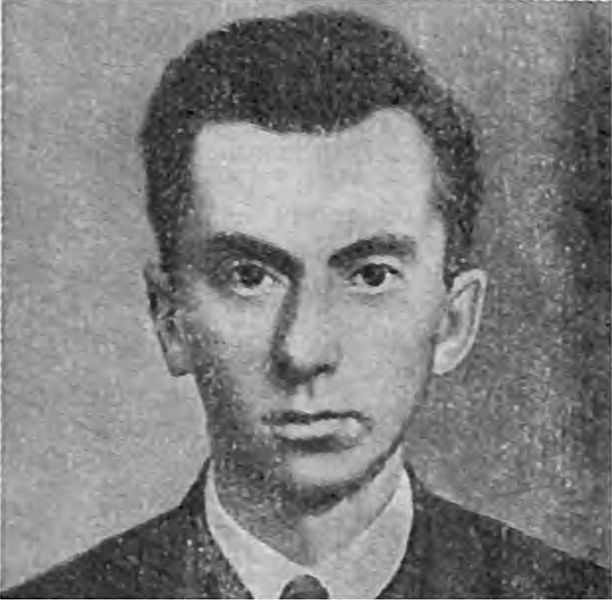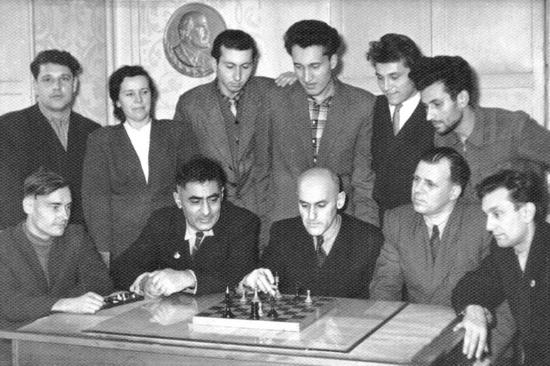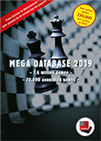Study of the Month: February 2019
In 1981 Rafael Kofman published his book on Mark Liburkin and Sergey Kaminer (Izbrannye etyudi Liburkina i Kaminera, which means “The selected studies of Liburkin and Kaminer”), two Russian composers of endgame studies. We had a study of Kaminer in May 2017 and although it would be worth going into deeper detail with Kaminer, today we will focus on Liburkin who also had a study in this column once before.
I sometimes stumble upon very interesting contemporary studies but, due to my concentration on earlier composers, have barely touched on them here. Readers can let us know in the comments if a selection of modern studies would be interesting to them once in a while, then without a specific theme but putting the main focus on the studies themselves instead of the authors.
That said, let us look at what is known about Mark S. Liburkin:
 Born on August 31 1910, in Russia, in his rather short life — he died from an illness on March 5th 1953 (according to the Schwalbe, the same day as Prokofiev) — he composed more than 110 endgame studies (some sources put the number at over 150), usually with geometrical motifs. The title of this column is hinting at Mark Liburkin’s profession as a finance expert. Sadly the Kofman book about the selected studies of Kaminer and Liburkin does not hold information about the personal life of Liburkin. Brian Stephenson seems to have had other sources translated by the late Paul Valois, detailing Liburkin as an accountant who in his final years worked for businesses seated in Moscow.
Born on August 31 1910, in Russia, in his rather short life — he died from an illness on March 5th 1953 (according to the Schwalbe, the same day as Prokofiev) — he composed more than 110 endgame studies (some sources put the number at over 150), usually with geometrical motifs. The title of this column is hinting at Mark Liburkin’s profession as a finance expert. Sadly the Kofman book about the selected studies of Kaminer and Liburkin does not hold information about the personal life of Liburkin. Brian Stephenson seems to have had other sources translated by the late Paul Valois, detailing Liburkin as an accountant who in his final years worked for businesses seated in Moscow.
Sadly, this is all of the personal information I can find about Liburkin. His honorary citizenship (where?) and medal for Socialist work have already been mentioned in the June 2017 column.
As Rafael Kofman writes, Liburkin’s interest in endgame studies arose in 1925 after reading an article by Leonid Kubbel. Liburkin usually would not publish his studies immediately but hold them back for months or years to find their final form. Thus the studies published first in Kofman’s book not always adhere to the standards Liburkin set for himself. The reputation of Liburkin led to his appointment as editor of the “Shakhmaty v SSSR” (“Chess in the USSR”) magazine for endgame studies in 1945, ended only by his death.

Kofman (who also edited "Chess in the USSR") moving the pieces in 1958 | Photo: chesspro.ru (uncredited)
As the Schwalbe declared in August 2010 on the occasion of Liburkin’s 100th birthday, his studies showed clear ideas and economic settings.
As no memorial tourney ever was organized for Liburkin in Russia, Yochanan Afek honored him in 2003, the 50th anniversary of his death, with a thematic tourney for endgame studies with “chameleon echo” as the theme, i.e. a pattern that repeats (in another variation usually) on a neighboring file, rank or diagonal. This was a favourite theme of Liburkin, which (as the tourney showed) is difficult to enforce in an endgame study. As Afek kindly informed us per e-mail, there was likely no personal information in that tourney report. He told us that Liburkin is one of his all-time favourite composers. Being the endless enthusiast he is, Afek celebrated Liburkin’s 100th birthday with ARVES and EG by organizing another memorial tourney, this time with the theme of systematic manoeuvers, another favorite of Liburkin. Afek also kindly provided us with information given to him by another great endgame enthusiast, Yuri Averbakh to which some background knowledge is provided first.
According to Dorfman in a 2009 interview in the French magazine Europe Échecs, the “category pyramid” was a system used in the Soviet Union to determine a player’s strength — fifth category being the lowest for beginners and first category being equal to a modern player of around 2000 Elo. After climbing the pyramid, one could ascend to titles similar to “Candidate Master” and “Master”, equaling around 2200 and 2400 modern Elo. According to Wikipedia, Peter Romanovsky in 1934 was the first player to achieve the “Master” title which was also tied to the honor of “Master of Sport of the USSR”. Less than 100 total “Master” titles, which were awarded to some players in USSR championships, were given out. The playing strength of those players is further confirmed by most of the players with that title also having been eligible for the FIDE titles of “International Master” or “Grandmaster”, at their time much rarer than today. Liburkin, according to Averbakh, was a player of the first category and participated in tournaments at the Central Chess Club in Moscow (which still exists on Gogolevsky Boulevard to this day).
As Kofman writes (and Afek reminded me), after Liburkin’s death, the co-authored book Sovietsky shakhmatny etyud (“The Soviet Chess Study”) was published in 1955 (with Rafael Kofman and Alexander Kazantsev). Like many Russian chess books (including Kofman’s 1981 book on Liburkin and Kaminer), it was printed by the Fizkultura i Sport in Moscow. Many of Liburkin’s compositions were later added to the FIDE Album, the anthology for chess compositions, when it was retroactively created for the years 1914-1944 (in three volumes) and 1945-1955.
We will show the winners of the Liburkin Memorials below, contrasting Liburkin’s own renderings of the ideas and other Liburkin studies, hoping the selection is enjoyable for readers. Note that his most famous works are left out, as they are reproduced many times on the internet, especially his extension of the Saavedra theme (Shakhmaty v SSSR 1931) which is available on many places, including Wikipedia. So we hope to have a “balanced diet” for readers to ingest.
PS: Readers interested in further information should also check out our comments section every now and then. For example, in our Duras article, two books in the English language on the master were found by commenters to whom we extend our thanks!
Both Russian books mentioned above, as well as the FIDE Albums, are available from time to time for antiquary purchase. Curiously, although the Russian books possibly were in the public domain in Russia, they never were in Berne Convention states and aren’t any more in Russia since 1993. This is another case where your author wishes someone would license and translate them into English, but then at least Kofman’s work has only few pages of information text, making it rather suited for an article or two in a magazine if someone can obtain the permissions by Kofman’s heirs, as the great author, also composer of over 400 problems, died at the age of 80 just days before Christmas 1988...
P.P.S: Complementary link to find EG 188, as mentioned in study 3.
 The "Mega" is the database every serious chessplayer needs. The database contains 7.6 million games from 1500 to 2018, in highest quality standard, full of top level analyses and completely classified.
The "Mega" is the database every serious chessplayer needs. The database contains 7.6 million games from 1500 to 2018, in highest quality standard, full of top level analyses and completely classified.You probably know that you can move pieces on our replay boards to analyse and even start an engine to help you. You can maximize the replayer, auto-play, flip the board and even change the piece style in the bar below the board.
At the bottom of the notation window on the right there are buttons for editing (delete, promote, cut lines, unannotate, undo, redo) save, play out the position against Fritz and even embed the ChessBase game viewer on your website or blog. Hovering the mouse over any button will show you its function.

World Federation for Chess Composition (www.wfcc.ch)
Links
.jpeg)

















 Born on August 31 1910, in Russia, in his rather short life — he died from an illness on March 5th 1953 (according to the Schwalbe, the same day as Prokofiev) — he composed more than 110 endgame studies (some sources put the number at over 150), usually with geometrical motifs. The title of this column is hinting at Mark Liburkin’s profession as a finance expert. Sadly the Kofman book about the selected studies of Kaminer and Liburkin does not hold information about the personal life of Liburkin.
Born on August 31 1910, in Russia, in his rather short life — he died from an illness on March 5th 1953 (according to the Schwalbe, the same day as Prokofiev) — he composed more than 110 endgame studies (some sources put the number at over 150), usually with geometrical motifs. The title of this column is hinting at Mark Liburkin’s profession as a finance expert. Sadly the Kofman book about the selected studies of Kaminer and Liburkin does not hold information about the personal life of Liburkin. 






